Every car owner should know at least in general terms the device of his car and be able to fix minor malfunctions, for example, replace burned-out high and low beam lamps, a turn signal or fog lamps.
Since troubles most often happen at the most inopportune moment, the need for such a replacement can overtake directly on the way. That is why it is better to have a minimum reserve with you. In order to provide it, you need to somehow navigate the abundance of devices and manufacturers of such goods. To help the buyer find out what car lamps are, how to choose the right product, which company is better to buy and how to replace a faulty one, the editorial staff of the site "bestx.htgetrid.com/en/" offers its review "The best halogen lamps for a car for 2020", compiled by according to customer reviews and expert opinion.
Content
- 1 Types of auto lamps
- 2 Lamp selection criteria
- 3 Top manufacturers
- 4 Rating of quality halogen lamps for cars
- 4.1 10th place: MTF Palladium HPA 1207 H7
- 4.2 9th place: Narva RangePover + 110%
- 4.3 8th place: PIAA Hyper Arros H7, 12V, 55W, 3900K
- 4.4 7th place: Bosch Gigalight Plus 120 H7
- 4.5 6th place: Hella Performance + 90% H7
- 4.6 5th place: Philips Racing Vision + 150% H4
- 4.7 4th place: Osram Night Breaker Unlimited H4 + 110%
- 4.8 3rd place: Koito WhiteBeam III H11
- 4.9 2nd place: Osram Allseason 64210 ALL-HCB H7 + 30%
- 4.10 1st place: General Electric Megalight Plus 58520 MPU H7
Types of auto lamps
Unlike home lighting fixtures, automotive lighting is almost always accompanied by vibration and shaking. Accordingly, the requirements for the equipment of cars are higher, and the design has some characteristic differences. They do not have an inch threaded base, since this version of the contact part is not reliable in the specified conditions. Spring-loaded locks and clamps are used here.
There are four main types of automotive lamps:
- Filament
- Halogen.
- Xenon
- LED.
Consider the design features of each of them.
Incandescent lamps
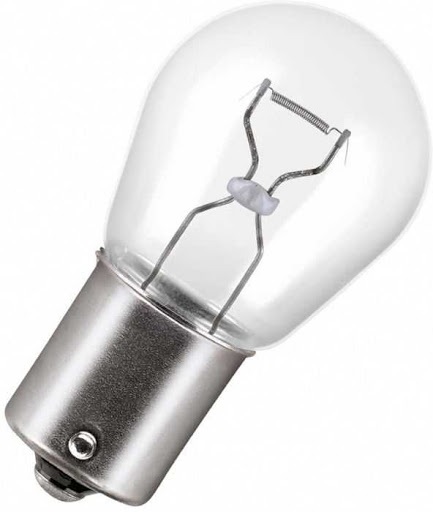
The simplest and most popular type of lighting fixtures. The design is classic, which has not changed much since Edison's time: a tungsten coil in a vacuum flask with a special base. When voltage is applied, the coil heats up to 2000 ° K (degrees Kelvin). At the same time, the thread begins to glow with an orange glow, dispersing the darkness around it.
Advantages:
- inexpensive;
- simple and reliable;
- practically do not flicker.
Disadvantages:
- small working resource;
- reaction to voltage drops;
- insufficient efficiency with significant energy consumption;
- inability to focus the beam with a reflector.
It should be admitted that this type of instrument is morally outdated and is no longer found in modern car models, since it is being supplanted by more modern developments.
Halogen
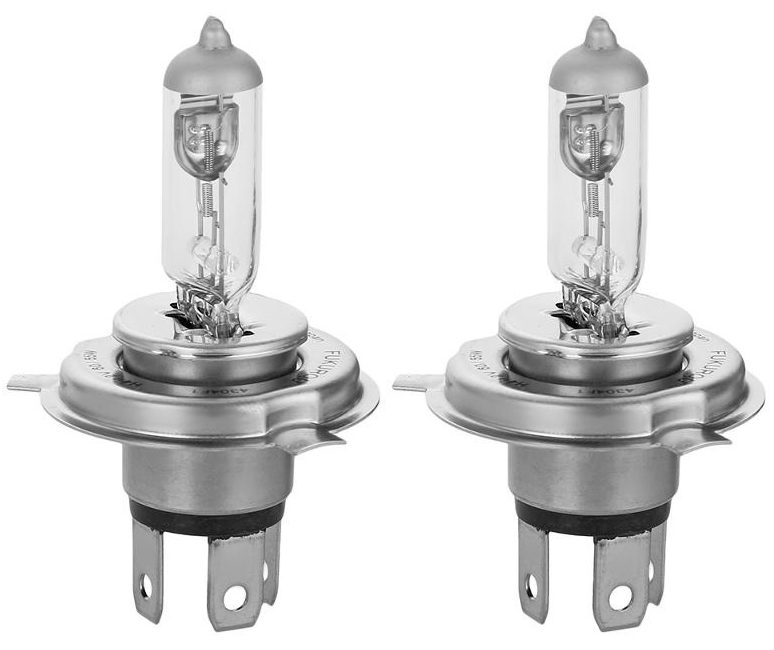
The main disadvantage of devices with a filament is their limited service life as a result of burnout of the tungsten filament.
Interesting! When high temperatures are reached, tungsten particles evaporate and settle on the flask, reducing its transparency. The tungsten filament wears out and breaks quickly.
A halogen lamp eliminates this disadvantage. Its flask is filled with halogen vapors (iodine or bromine plus a small amount of residual oxygen), which do not allow tungsten particles to "go far" from the spiral, facilitate their return and settle on the filament. As a result, the working life of the product increases, and the value of its color temperature increases to 2700-3500 ° K.
With all the obvious advantages of halogens, they have a significant drawback: they cannot be grabbed with bare hands, even when taking them out of the package, since the internal energy of the bulb is disturbed, and this inevitably ends in a crack.
Xenon
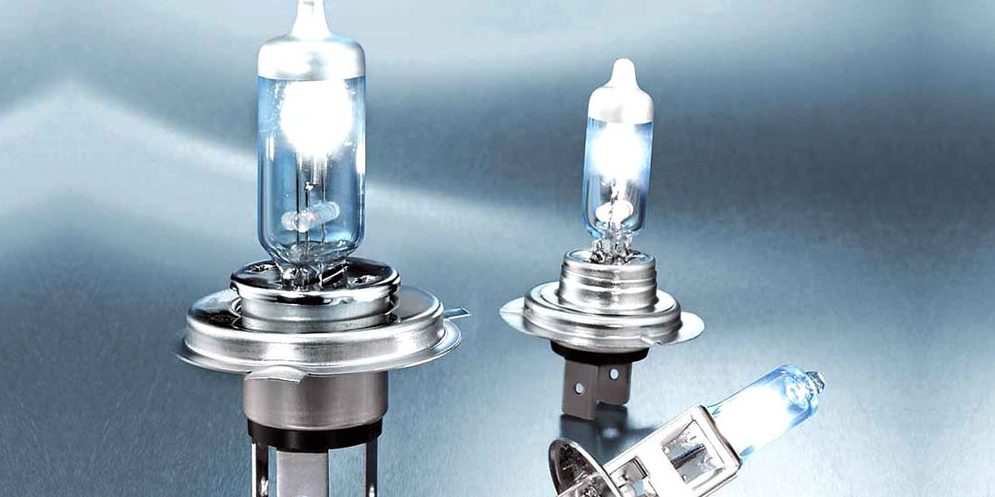
They are called gas discharge. This is a completely new type of lighting fixture.
Interesting! What distinguishes them from the usual incandescent lamps and their related halogen lamps is that there is no filament here. The flask filled with xenon contains two electrodes. When voltage is applied, a stable electric discharge (arc) arises between them, the glow of which, reinforced by a reflector, illuminates the space in a given direction.
Visually, xenon devices resemble halogen ones, but in comparison with the latter they have a number of advantages.
Advantages:
- their color temperature reaches 8000 ° K;
- efficiency is higher than that of other types of devices;
- they easily tolerate shaking and vibration, since they do not have a filament;
- the working resource is an order of magnitude higher than that of halogen.
Disadvantages:
- to ignite the arc requires a voltage of 20-30 thousand volts, and in order to "get" such a voltage from the on-board power supply system, you will need an ignition unit consisting of low-voltage and high-voltage circuits (the circuit uses expensive equipment: a microcircuit, transistor amplifiers and high-voltage transformers) ;
- a powerful beam will blind the drivers of oncoming cars;
- replacement of standard light sources with xenon ones in cars is prohibited.
To avoid "misunderstandings", let us explain the last point of the list of shortcomings.
Important! If the manufacturer of your car did not provide for the use of xenon devices, then it is prohibited to install them yourself instead of halogen or LED ones! This is a gross violation of the rules and is punishable by deprivation of rights for up to a year.
LED lamp
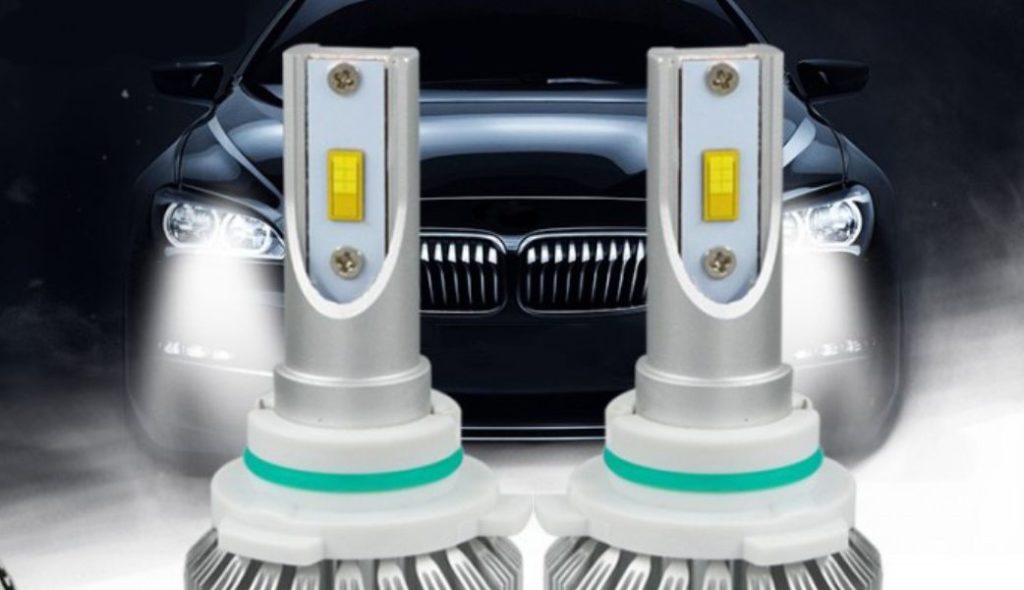
Light sources of increased brightness. A completely new type of lighting fixture. No filament, no arc. Nothing heats up, but for some reason it shines. It uses a completely different way of converting electricity into light.
All substances surrounding us are divided into three types:
- Conductors. Substances that conduct electric current (metals).
- Dielectrics. Non-conductive substances (wood).
- Semiconductors. Substances that exhibit the properties of conductors or dielectrics, depending on the surrounding conditions. In a cold state, it is a dielectric, but as soon as it is heated, it is already a conductor.
The LED requires semiconductors. They are obtained in the laboratory. On the crystal lattice of an artificial sapphire crystal, which does not conduct electric current, a layer of conductive metals is grown: indium, gallium, aluminum. The resulting product differs from the base (artificial sapphire) by the presence of free electrons at the outer levels, i.e. such electrons, which do not fly in a certain orbit around the atom, but are torn off from their place, leaving in their place a "hole", which is a bunch of an electromagnetic field.
Interesting! The presence of free electrons in a substance determines its conductivity. When voltage is applied, free electrons begin to move towards the "holes", ejecting photons of light.
LED lamps have a lot of undeniable advantages.
Advantages:
- resistant to shock and vibration;
- have a large work resource;
- consume an order of magnitude less energy;
- have the highest color temperature;
- very environmentally friendly.
Disadvantages:
- not detected.
Lamp selection criteria
Traffic safety depends on the health of the light sources of the car, especially at night. The abundance of such devices on the market can be confusing to the inexperienced buyer.It is easy to fall for the enticing prices of cheap Chinese appliances. However, the number of options is greatly reduced when you know what to look for.
To correctly determine the type of halogen light sources used by a particular manufacturer, you need to familiarize yourself with their characteristics and features of the device and installation (replacement).
Marking
Lamps are distinguished by purpose:
- for headlights and fog lights;
- side marker lights;
- front and rear brake lights;
- turn and reverse indicators;
- for salon lighting;
- license plate illumination.
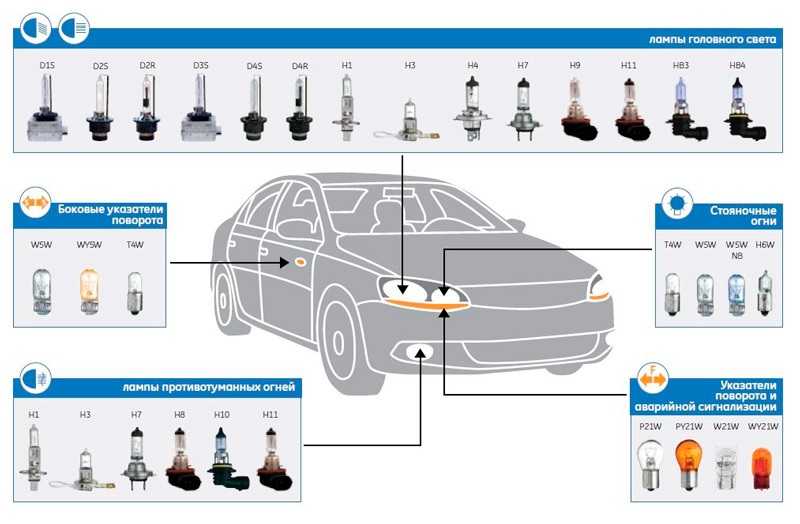
There are more than a dozen light sources even for one car. If we also imagine the number of different car models produced in different parts of the world, and try to determine their general need, it becomes clear that this market is huge. With so many types of products and manufacturers, it is very easy to get confused in choosing the right product. Therefore, there was a need for marking indicating its technical characteristics. That's what came out of it.
Base / plinth marking
The plinths are equipped with a different number of contacts. This difference is indicated as follows:
- d - with two contacts;
- t - with three contacts;
- q - with four contacts;
- p - with five contacts;
- s - with one contact.
In addition to the number of contacts, designations are applied to the base that carry the following information:
- W - with glass flask and base;
- R - with base Ø15 mm in diameter and flask Ø 19 mm;
- R2 - with a Ø40 flask (outdated model for old cars of the Soviet car industry);
- P - flask Ø up to 26.5 mm and base Ø15 mm;
- AMN - designation of automobile miniature;
- Y - orange flask;
- AKG - quartz halogen;
- SV (C) - soffit with two plinths for interior and license plate lighting;
- BA - symmetrical pins;
- BAY - one pin is offset in height;
- BAZ - one pin offset in height and circumference.
Standard size
The base provides:
- flask tightness;
- holding the device in the socket;
- power supply from the on-board power supply system.
There are the following base / plinth sizes: H1, H2, H3 and H4. This is followed by H7, H8, H9, H11, H13 and, finally, the "halogen" American cars: HB1, HB2, HB3, HB4 and HB5. Let's consider each separately:
- H1 type. Designed to operate on a 12-volt automotive power supply. They have a power of 55 W and are installed in fog lights. The beam with a color temperature of 4000K is not scattered and is directed to the roadbed. For some time they were equipped with low / high beam headlights.
- Type H2. They are equipped with head light equipment, but exclusively in French-made cars.
- Type H3. They work in fog lamps and headlights. Unlike other types, they are easy to install themselves.
- Type H4. Products with high and low beam function at the same time. They have two spirals (low / high beam). Mounted in fog lights and headlights. The most popular standard size. Powered by 12V mains, 55W power with 1000 lumen lumen output. Not too bright, but also does not blind the drivers of oncoming cars.
- Type H7. On sale since mid-90s. They have one spiral and are used in head lighting devices. The power is 55 W and the lumen output is 1500 lumens.
- Types H8,9 and H11 have a plastic sealing base. They are installed in small headlights, often together with HB3 and 4 for high and low beam.
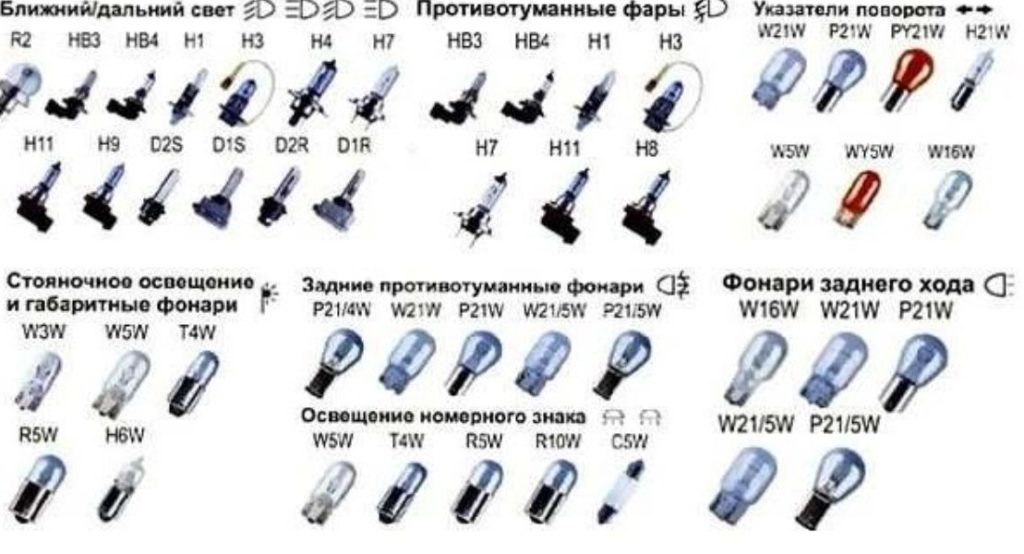
If the time has come to replace the lamp, but it was not possible to determine the type of base, then the easiest way is to present the faulty one to the seller in the store. Those who are literate can look through the accompanying documentation for their vehicle and find the type they need there.
Differences in color temperature
Among other technical characteristics of automotive light sources, there is also a color temperature, measured in degrees Kelvin. Visually, it is determined by the shade of the light beam:
- warm white light corresponds to a color temperature not exceeding 3500K;
- natural white (daylight) light corresponds to a temperature in the range from 3500 to 5500 K;
- cool white light with a bluish tint corresponds to a temperature exceeding 5500K.
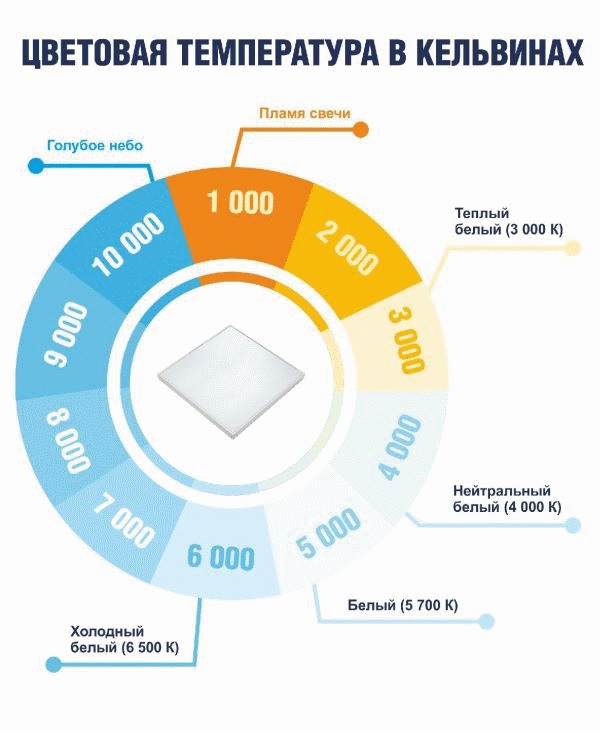
The human eye is more accustomed to light, close to daylight, since with this lighting the driver's eyes are less tired. However, the whiter the color of the beam, the more it is reflected from the moisture contained in the air, which is especially pronounced when the car is moving in fog and rain. Therefore, the fog lights are equipped with lamps of warm white (yellow) color, with a temperature of up to 3500 K.
On a note! Some manufacturers give halogen bulbs a blue color - "with xenon effect" to increase the color temperature.
The color temperature of such products, of course, rises to 5,000K, but such a "filter" reduces the luminous flux.
Power selection
Any electrical appliance has a "power consumption" characteristic. Car lighting equipment is no exception. The service life of halogen lamps is 600 hours on average. On-board voltage has a serious impact on this figure. Its value is considered to be optimal, equal to 13.2 V. Its increase will entail an increase in the luminous flux, but will lead to a reduction in the lamp life.
Reduced voltage prolongs their life, but reduces the intensity of light. Sources common for head lighting produce a power of 60/55 W, respectively for high / low beam.
An increase in power threatens to overload the on-board power supply system. Such experiments can and will give a short-term increase in the luminous flux, but everything will end very badly, up to the failure of the electronics or even the fire of the electrical wiring.
Luminous flux
Measured in lumens. The buyer, busy with the choice, always strives to purchase a product with more lumens. This is understandable. However, it should be remembered that high-quality road lighting largely depends not only on the characteristics of the source, but also on the design features of the headlamp and its reflectors, i.e. from everything that motorists call optics. For example, the average luminous flux of H4 halogens is considered to be 1650/1000 lumens (high / low beam).
You can often find products on store shelves that promise, at standard power (60/55 W), an increased luminous flux from +30 to + 130%. This is achieved by reducing the diameter of the tungsten filament by some part of a percent, plus the addition of special substances to the halogen composition (we will not specify). The tests carried out showed some improvement in the illumination of the roadway from such lighting devices.
The stated percentages are not always confirmed, but these "bells and whistles" are reflected in the price upward. At the same time, a short-term test does not show how long such a miracle will last, but you will have to pay for it (or rather overpay) here and now, so the best option is to purchase a standard model instead of a failed one.
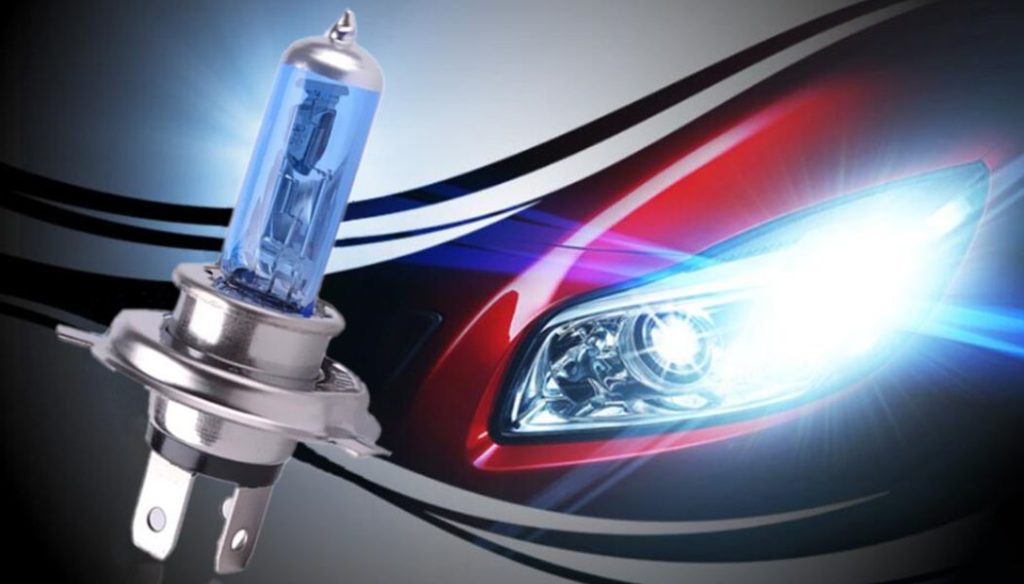
Top manufacturers
Philips
World famous brand from the Kingdom of the Netherlands. The quality of Philips home appliances and electronics does not need additional advertising. The popularity of the models of this brand is based on the introduction of innovative developments in the field of energy efficient lighting technology.
Narva
The largest German company for the production of lighting fixtures for cars. Its products are familiar to customers in over 70 countries around the world. The company's motto is reliability and quality.
General Electric
World renowned American corporation founded in 1878 by Thomas Alva Edison. Today, it is a multi-disciplinary and multi-purpose empire that deals with everything from turbines and nuclear reactors to space systems and weapons, medical equipment, photographic equipment and household electrical appliances.
The world's largest supplier and manufacturer of automotive headlights.
Osram
Automotive lighting manufacturer from Germany. Not so long ago - a subsidiary of Siemens. Popular Osram models are in demand among buyers all over the world.
Bosch
Products of this German brand are in high demand on the world market.Since the time of the founder of the company, its motto is "it is better to lose money than the trust of the buyer." In the auto parts market, Bosh is famous for its automotive lighting equipment, xenon gas discharge units and other components.
Koito
One of the leaders in the production of automotive lighting equipment. The products of the Japanese company are in high demand both in the land of the rising sun and far beyond its borders. One of Kioto's latest developments is a range of compact and energy efficient xenon and LED sources for headlights and fog lamps.
Sho-Me
A manufacturer of car electronics, equipment and components from South Korea. One of the leaders in the world market among manufacturers of parking sensors, LED, halogen and xenon lamps, washers, etc.
MTF Light
Russian company founded in 2005. Delivers its products to the domestic market. Lighting equipment for cars from MTF Light is in high demand among buyers due to its decent quality and affordable price.
SVS
The domestic manufacturer produces low-cost and high-quality components, as well as spare parts for both domestic and foreign cars. Seriously competes with foreign brands. Specialized in the production of halogen, LED and xenon lamps.
The list of the best manufacturers is far from complete. Which company is better to buy a product depends on the type of standard lighting sources for this car, the voltage value of the on-board power supply network, the design of automotive optics and, last but not least, on how much the chosen option costs.
If in doubt, it is better to listen to the advice and recommendations of professionals, ask them what to pay special attention to when buying such a product, and also carefully read the description of the device.
Rating of quality halogen lamps for cars
10th place: MTF Palladium HPA 1207 H7
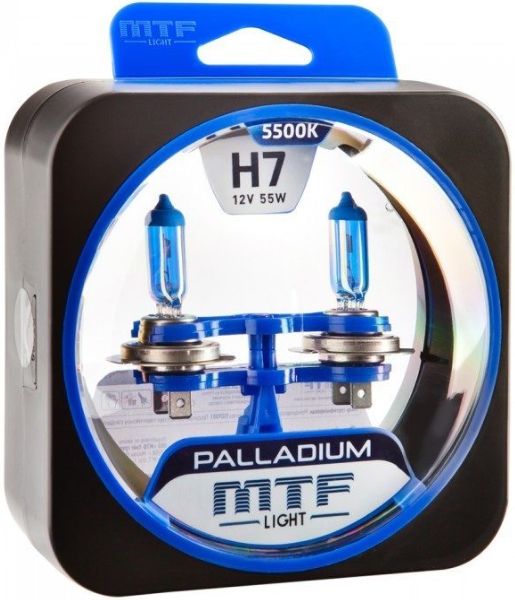
Product for head light (low / high) and fog lamps of the Russian manufacturer MTF. The color temperature of 3500 K corresponds to warm white light. The luminous intensity indicators do not exceed 468 lumens with a power of 55 W and a voltage of 12 V. The average cost of a set of two pieces is 845 rubles.
Advantages:
- does not irritate the eyes;
- does not blind the driver;
- affordable price;
- will not overload the on-board power supply system.
Disadvantages:
- small aperture;
- slight brightness.
9th place: Narva RangePover + 110%
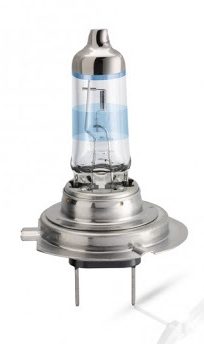
A device from a German manufacturer with an increased luminous flux up to 110%. This allows the driver to see the road 10-20 m further than usual at night. The beam is white, natural, close to daylight, slightly yellow, since the bulb is only partially colored blue. Powered by 12 V, power - 55 W. With H7 base, it can be used for head (low / high) lighting and fog lamps. The average cost is 642 rubles.
Advantages:
- improves visibility on the road;
- does not blind oncoming drivers;
- captures the roadside well;
- affordable price;
- great quality.
Disadvantages:
- not identified.
8th place: PIAA Hyper Arros H7, 12V, 55W, 3900K
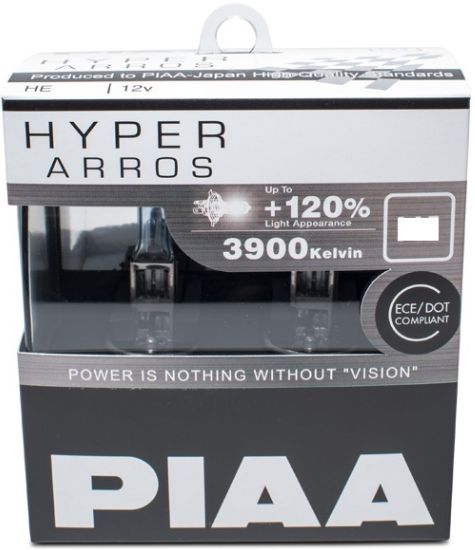
Japanese-made product with increased luminosity. They are made of high quality materials, which guarantees the declared color temperature of 3900 K and an increased range of illumination of the roadbed. Color - white, cold and close to daylight, provides excellent illumination of the roadway and shoulder. Products are produced with H7 base and 55 W for operation with a voltage of 12 V. They are used in headlights.
Manufactured in accordance with international ECE and DOT standards.
A set of two pieces costs an average of 1,599 rubles.
Advantages:
- decent brightness;
- the color does not irritate the driver;
- affordable price.
Disadvantages:
- the service life does not exceed one year.
7th place: Bosch Gigalight Plus 120 H7
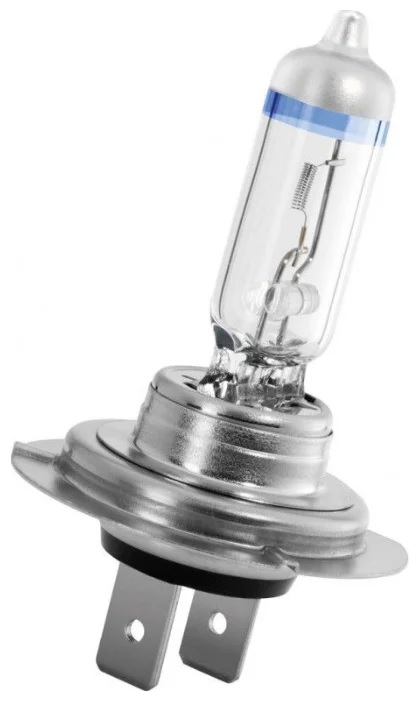
Almost all buyers like the Bosch plus halogen. Its brightness is indeed higher than standard values.Color - white (warm) - does not irritate the eyes and does not blind oncoming drivers. The manufacturer filled the flask with xenon. The device of standard size H7 and power of 55W operates from a 12V power supply. Despite the increased brightness, it will not overload the hog power supply network. Feedback from buyers is only positive. The average price is 568 rubles.
Advantages:
- high quality;
- increased brightness;
- does not irritate the eyes;
- does not blind oncoming drivers.
Disadvantages:
- not identified.
6th place: Hella Performance + 90% H7

Plus halogen from a German manufacturer. Power - 55 W, voltage - 12 V. Designed for fog lights, low and high beam. According to customer reviews, it shines brightly enough, providing excellent visibility of the roadway and the shoulder, even in rainy weather. Made with traditionally high German quality. It is sold at an affordable price of 679 rubles.
Advantages:
- great quality;
- working resource - at least a year;
- good range and luminosity;
- affordable price.
Disadvantages:
- not identified.
5th place: Philips Racing Vision + 150% H4
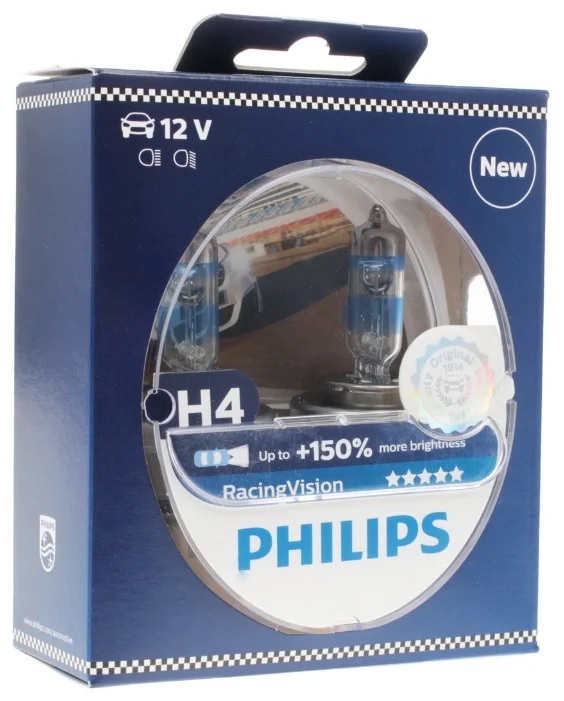
Dutch brand products are widely known among car enthusiasts. The Racing Vision + 150% H4 is designed for high and low beam. Color temperature - 3,500K. Color - white (warm) - does not irritate the eyes and does not blind the drivers of oncoming cars. The luminous flux is at least 1,650 lumens. Power and voltage parameters are respectively 55W and 12V.
Sold in a set of two for 949 rubles.
Advantages:
- high quality assembly and workmanship;
- soft white color does not irritate the eyes;
- the range, as well as the illumination of the road and shoulder, is above average.
Disadvantages:
- short service life.
4th place: Osram Night Breaker Unlimited H4 + 110%
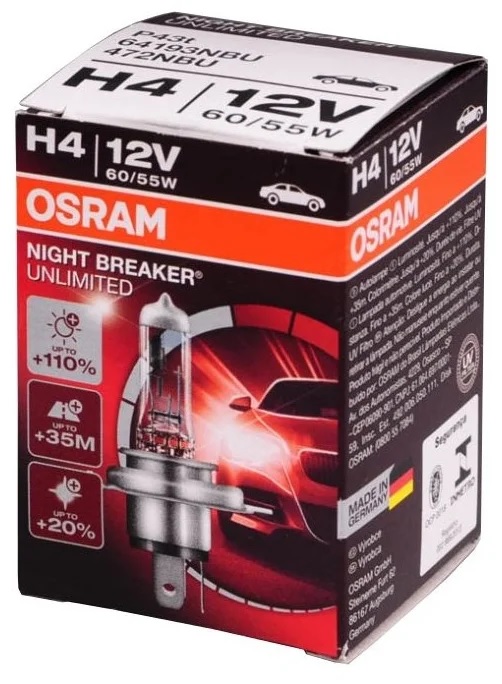
Another product from Germany with H4 base and two spirals. Performs the functions of near and far lighting. A very popular product among motorists with a power of 60 / 55W and a voltage of 12V. With a color temperature of 3900K, it illuminates the road with a cool white light with a brightness of 1,680 lumens. The set, which costs 852 rubles, includes two pieces, therefore, the average price of one is quite affordable.
Advantages:
- high quality;
- unique functionality;
- range, as well as brightness of roadbed and shoulder lighting;
- long working life;
- affordable price.
Disadvantages:
- not identified.
3rd place: Koito WhiteBeam III H11
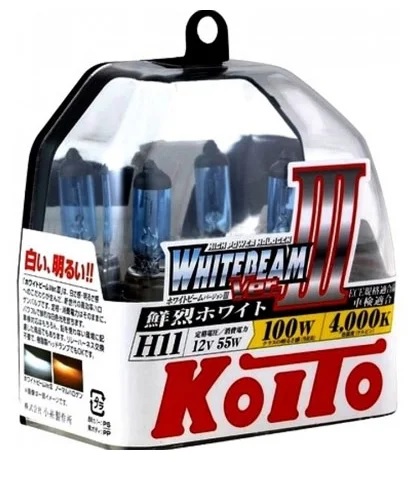
The Japanese company Koito manufactures halogen lamps for fog lamps for low and high beam with an H11 base and a color temperature of 4000K for a 12-volt voltage. The manufacturer has depicted the inscription "100 W" on the packaging. Don't be scared. In fact, the power is the same as everyone else's - 55 W (this is also written on the package, but in smaller numbers). With its marking, the manufacturer wants to show that the lamp shines as 100-watt, i.e. twice as bright. Such a marketing ploy. A set of two pieces costs 1,830 rubles.
Advantages:
- bright cold white (daytime) color;
- the flask is painted in blue "xenon";
- working resource - more than a year.
Disadvantages;
- the price "bites".
2nd place: Osram Allseason 64210 ALL-HCB H7 + 30%
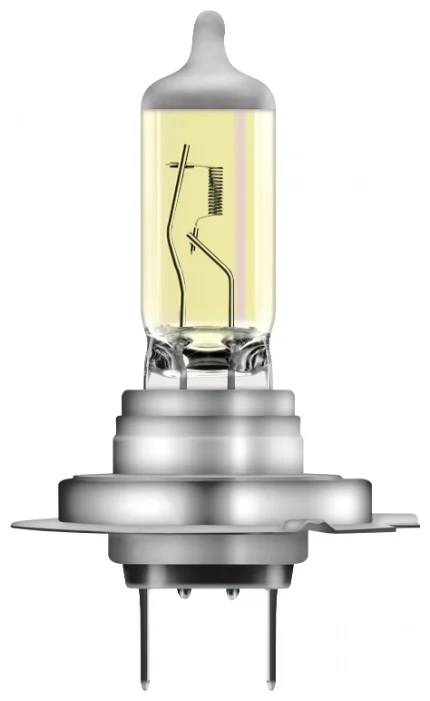
Another product of a popular German manufacturer. With a warm white light, 3200K color temperature, 55W, 12V, and 1,500 lumens, it is a popular choice among car enthusiasts. Its light is bright enough to confidently drive in the night, rain and fog, does not hurt the eyes, and does not blind oncoming drivers and does not glare. With H7 base, it is installed in headlights (low / high). The kit consists of two pieces and will cost the buyer 969 rubles. According to buyers, this is a very good value for money.
Advantages:
- warm white color does not hurt the eyes;
- perfectly illuminates the road and side;
- long working life;
- affordable price.
Disadvantages:
- not identified.
1st place: General Electric Megalight Plus 58520 MPU H7
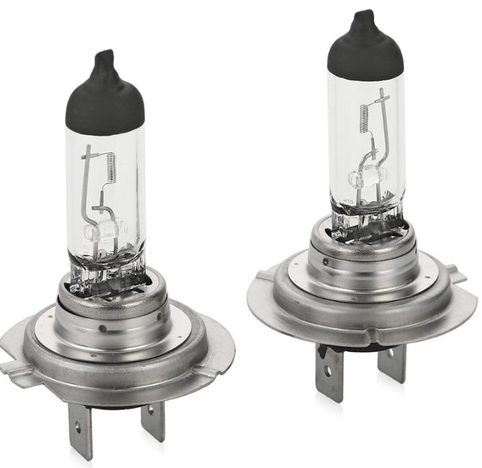
The first line in the rating and the best reviews is received by the product of the American concern with the H7 base, designed for equipping headlights. It can also be used in fog lights. Color - warm white with a temperature of 3250K. The lamp, with a power of 55 W, works in a network with a voltage of 12 V.
According to users, the brightness is superior to Osram Allseason. The quality of workmanship and assembly guarantees long-term operation. The kit consists of two pieces, and can be purchased at a price of 1,147 rubles.
Advantages:
- shines brightly;
- "Hits" far away;
- serves for a long time;
- does not glare.
Disadvantages:
- expensive.
Buying automotive halogen lamps can be a serious problem if you do not understand the markings, types of caps and technical characteristics of both the lamps themselves and the existing automotive lighting equipment. We hope that our review helped to remove all the questions that arose, to purchase a product suitable for all articles and not to make mistakes when choosing. Your safety on the roads depends on it. Bon Voyage!












